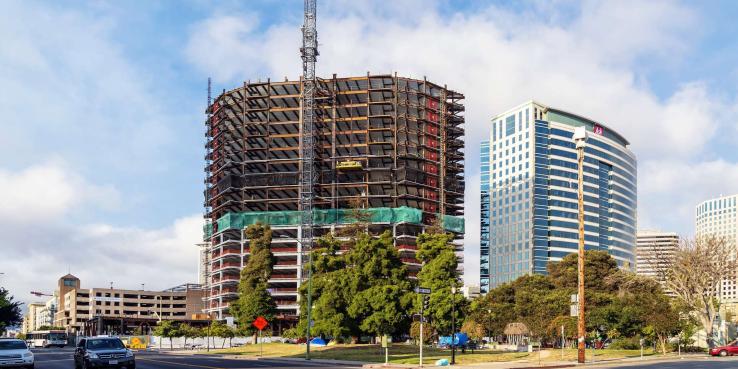Since 2008, anyone who has entered downtown Oakland from I-980’s 12th Street off-ramp has passed the big hole in the ground at 601 City Center, site of Shorenstein Properties’ frozen-in-time construction project. As the story goes, the steel for the 24-story, 600,000-square-foot office tower was purchased and the excavation begun when the financial crisis of 2008 halted the project. The steel has sat since then in the Arizona desert, as Shorenstein waited for the right time to restart construction.
Well, that time has come. Downtown Oakland now has the tightest commercial market in the country, with a vacancy rate of 5.3 percent. (In second place is San Francisco, with a 5.7 percent vacancy rate, and in third is Manhattan’s Midtown South, with a 6.5 percent vacancy rate.) The demand is coming from existing tenants who are expanding, as well as from new companies moving into the city. As a result, commercial rents in downtown Oakland have shot up. After many years of construction costs stubbornly remaining higher than commercial rents, it has finally become financially feasible to build new office buildings downtown.
Earlier this year Shorenstein Properties restarted construction at 601 City Center. That was followed soon after by the start of excavation at 1100 Broadway, where Ellis Partners will erect a 334,000-square-foot office tower. Renovation continues at Uptown Station and at 2150 Webster, where French cosmetics firm Sephora is in talks with Lane Partners to take the whole building.
Further uptown, at 2100 Telegraph, design and environmental review continue for the 1.6 million-square-foot Eastline Project, and CIM has proposed an office tower of either 400,000 or 800,000 square feet at 2 Kaiser Plaza. All of this is quite a turnaround from prior years: Between 2000 and 2015, only one new office building was built and one commercial addition was completed.
In our report A Downtown for Everyone: Shaping the Future of Downtown Oakland, we identified three obstacles that were making it hard to build new office buildings in downtown Oakland: a lack of office tenants to reliably fill new buildings, market rents remaining lower than construction costs, and the wariness of institutional investors to lend in downtown Oakland. All of these appear to have flipped in the last three years.
Commercial rents in downtown Oakland are now, in fact, the highest that they have ever been, which isn’t news to anyone currently looking for space there. In the long run, the coming buildings should mean that the supply of commercial property in Oakland might start to come closer to meeting the demand. It should also bring downtown Oakland closer to welcoming the 50,000 new jobs that SPUR has recommended it add. Most importantly, it should mean that Oakland starts to see the benefit of a downtown that generates sufficient taxes and investment — and that the city can once again afford to provide the level of public services Oaklanders need. Out of the pain that many are now experiencing could come Oakland’s long-term gain.
